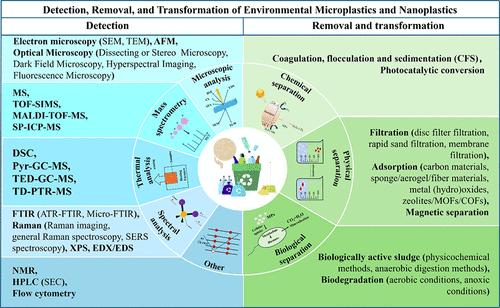环境微塑料和纳米塑料的检测、去除和转化技术综述
IF 8.2
2区 材料科学
Q1 MATERIALS SCIENCE, MULTIDISCIPLINARY
引用次数: 0
摘要
塑料残留物已成为环境部门面临的重大挑战。微塑料是一种小于5毫米的塑料碎片,能够通过大气、海洋和陆地扩散,通过在食物链中积累对人类健康构成严重威胁。然而,它们的微小尺寸使得使用现有技术很难有效地将它们从环境中移除。这项工作提供了微塑料检测和去除技术的最新进展的全面概述。对于检测方法,我们讨论了常用的技术,如显微分析、热分析、质谱分析、光谱分析和能谱分析。我们还强调整合各种分析和数据处理技术的重要性,以实现微塑料的高效和无损检测。在去除策略方面,我们探索了从环境中提取微塑料的创新方法和技术。这些技术包括过滤、吸附和磁分离等物理技术;混凝-絮凝-沉淀、光催化转化等化学技术;和生物分离方法如活性污泥和生物降解。我们还强调了将微塑料污染物转化为高价值化学品的巨大潜力。此外,我们还确定了当前的技术挑战,并提出了未来检测和去除微塑料的研究方向。我们主张制定统一和标准化的分析方法,以指导微塑料的去除和转化的进一步研究。本文章由计算机程序翻译,如有差异,请以英文原文为准。

Review of Techniques for the Detection, Removal, and Transformation of Environmental Microplastics and Nanoplastics
Plastic residues have emerged as a significant challenge in the environmental sector. Microplastics, which are plastic fragments smaller than 5 mm, have the ability to disperse through the atmosphere, oceans, and land, posing a serious threat to human health by accumulating in the food chain. However, their minuscule size makes it difficult to effectively remove them from the environment using the current technologies. This work provides a comprehensive overview of recent advancements in microplastic detection and removal technologies. For detection methods, we discuss commonly used techniques such as microscopic analysis, thermal analysis, mass spectrometry, spectroscopic analysis, and energy spectrometry. We also emphasize the importance of integrating various analytical and data-processing techniques to achieve efficient and nondestructive detection of microplastics. In terms of removal strategies, we explored innovative methods and technologies for extracting microplastics from the environment. These include physical techniques like filtration, adsorption, and magnetic separation; chemical techniques such as coagulation–flocculation–sedimentation and photocatalytic conversion; and bioseparation methods such as activated sludge and biodegradation. We also highlight the promising potential for converting microplastic contaminants into high-value chemicals. Additionally, we identify current technical challenges and suggest future research directions for the detection and removal of microplastics. We advocate for the development of unified and standardized analytical methods to guide further research on the removal and transformation of microplastics.
求助全文
通过发布文献求助,成功后即可免费获取论文全文。
去求助
来源期刊

ACS Applied Materials & Interfaces
工程技术-材料科学:综合
CiteScore
16.00
自引率
6.30%
发文量
4978
审稿时长
1.8 months
期刊介绍:
ACS Applied Materials & Interfaces is a leading interdisciplinary journal that brings together chemists, engineers, physicists, and biologists to explore the development and utilization of newly-discovered materials and interfacial processes for specific applications. Our journal has experienced remarkable growth since its establishment in 2009, both in terms of the number of articles published and the impact of the research showcased. We are proud to foster a truly global community, with the majority of published articles originating from outside the United States, reflecting the rapid growth of applied research worldwide.
 求助内容:
求助内容: 应助结果提醒方式:
应助结果提醒方式:


